check oil VOLKSWAGEN GOLF 2008 User Guide
[x] Cancel search | Manufacturer: VOLKSWAGEN, Model Year: 2008, Model line: GOLF, Model: VOLKSWAGEN GOLF 2008Pages: 444, PDF Size: 92.7 MB
Page 41 of 444
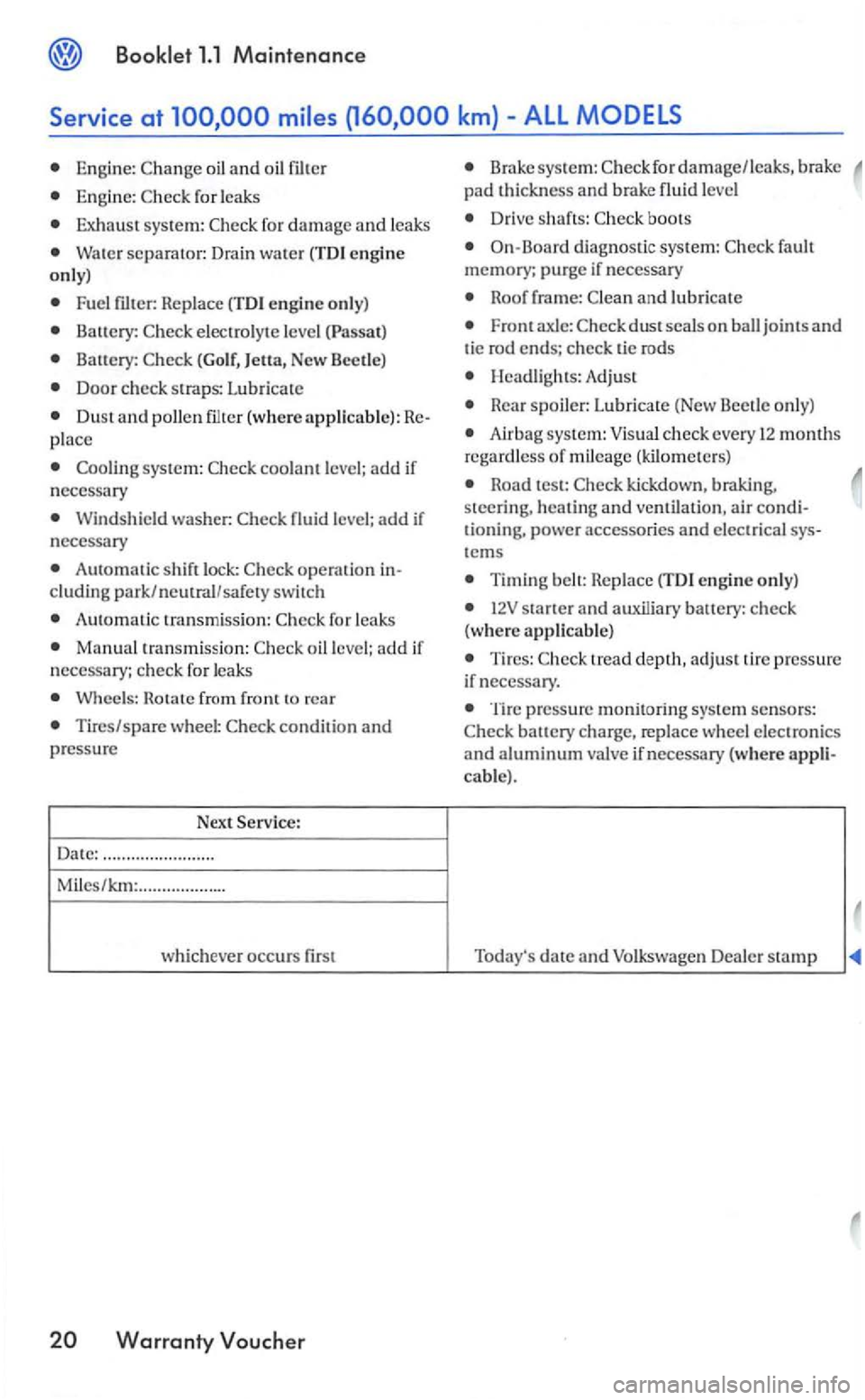
Engine: oil and oil filter
Engine: for leaks
Exhaust system: fo r damage and leaks
Water separator: Drain water (TDI e ngi ne only)
Fuel
electrolyte level
Battery: (Golf, )etta, New
Door check straps: Lubricate
s ystem:
Windshield washer:
Automatic sh ift lock:
Automatic transmiss ion:
Manual transmiss ion:
Wheels:
Tires/spare wheel :
Date: .................. ... ...
Miles/km: .................. .
which ev
er occurs first
Brake system: for damage/leaks, brak e pad thickness and brake fluid
Drive shafts: boots
On-Board diagnos tic system: fault
memory; purge if nece ssary
Roof frame: and lubricate
Front axle: jo int s and tie rod ends; ch eck tie rods
Hea dligh ts : Adjust
Rear sp oile r: Lub ricate (New Beetle only)
Airbag system: Visual check every 12 months regardless of mileage (kilom eters)
Road test: kickdown , braking, steering, heating and ventilation , air conditioning, powe r accessories and electrical systems
Timing belt: Replace (TDI engine only)
starter and auxiliary banery: check
( w here applicable)
T ires: tread dept h, adjust tire pressure
if nec essary _
Tire pressure monitoring system sen sors: battery charge, replace wheel electronics and aluminum valve if necessary (whe re appli
cable) .
date and Volkswagen Dealer stamp
Page 289 of 444
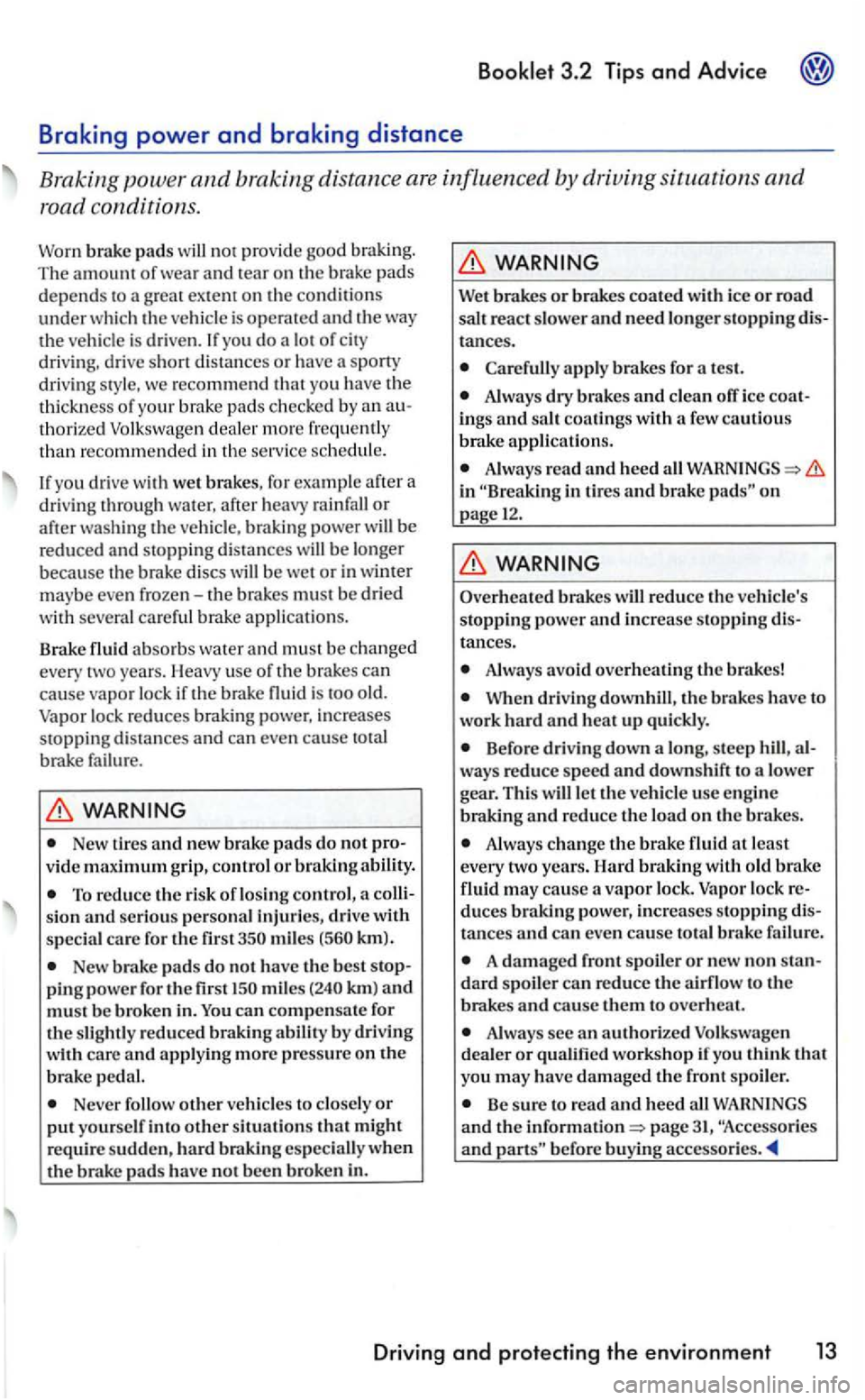
Booklet 3 .2 Tips and Advic e
recommend that you have the
thi ckne ss of your brake pads checked by an au
t horized Vol kswagen dealer mo re fre quent ly
t h an recommende d in the serv ice sched ule.
you drive with wet brakes, for example afte r a
dri ving through water, after heavy rainfall or after washing the ve hicle, braking power be
reduced and s to ppin g distances will be longer
because the brake discs will be we t or in winter mayb e eve n frozen-the brakes must be dried
with several ca re ful brak e applicatio ns.
Brak e fluid absor bs water
and must be changed
every two years. Heavy use of the brakes can cause vapor lock if the brake fluid is too old.
Vapor lock redu ces braking power, increases
stopping distances and ca n even cause total
brake failure.
New tires and new bra ke pads do no t pro
v id e m aximum gri p, control o r b raking abil ity.
To red uce the risk of l osi ng control, a s io n an d se rio us perso nal injuries, drive with
specia l ca re for the first 350 miles (560 km).
New brake pads do not have th e best sto p
ping power for the fir st ISO mile s (240 km ) and
m ust be b roken in. can compensate for the slightly reduced braki ng abil ity by dri ving care and applyin g more pressure on th e
brake pedal.
Never follow oth e r veh icles to close ly or
p u t you rse lf in to other s ituations th at might
requ ire su d den , hard bra king especially when the brake pads have not been broken in.
apply brakes for a test.
Always dry brakes and clea n off icc coat
i ngs an d salt coatings with a few cautious brake applications.
A lways read and heed in in tire s and brake on page 12.
Always avoid overheati ng the brakes!
When driving downhill, t11 e brakes have to
work har d and h eat up quickly.
Before driving down a lo ng, steep hill, al
ways reduce speed and downshift to a lower
gear. This will let the vehicle usc engine
Always ch ange th e brake fluid at l east
every two years. Hard braki ng wi th o ld flui d may cause a va po r lock . Vapor loc k duces powe r, inc reases stoppin g di stan ces and can even cause tota l b rak e failure.
A damaged front spoiler or n ew non standard spoiler can reduce t h e airflow to th e
brakes and cause them to ove rh eat.
Always see an authorized Volkswag en
dealer or qualified workshop
Be sure to re ad and heed all and th e page
Driving and protecting the environm ent 13
Page 316 of 444
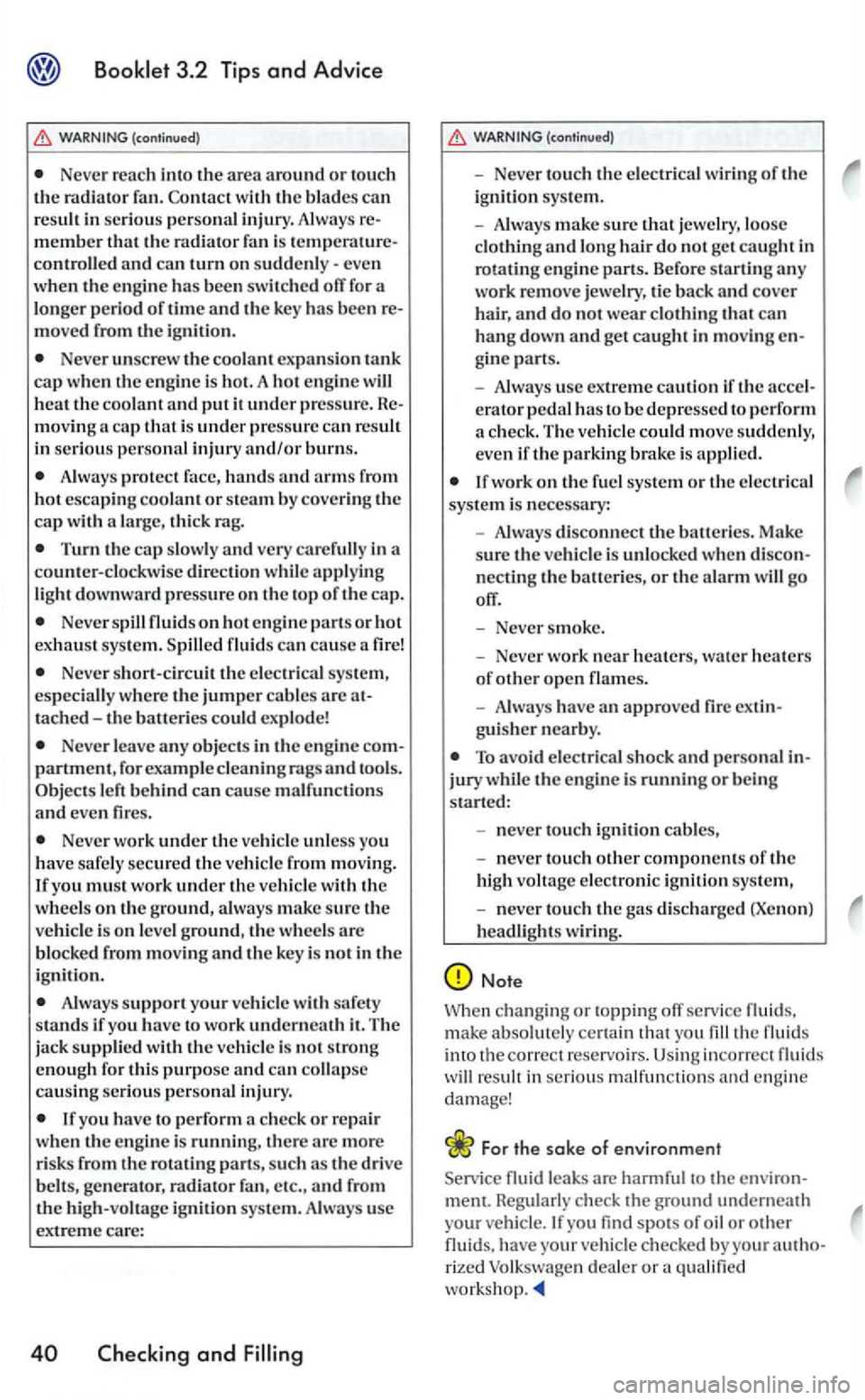
WARNING (continued)
Never reach into the area around or tou ch the radiator fan. Contact w ith the blade s can resuh in se riou s personal injury. Always m ember that the radiator fan is controll ed and can turn on
m oved from the ignit ion.
Never unscrew the coolant expa nsio n tank cap when th e engin e is hot. A hot engine will heat the coo la nt and put it under pressure . mov in g a cap that i s under pressure ca n rcsuh in seriou s personal injury and/or burns.
A lway s prote ct face, hand s and arms from hot esca ping coolant or steam b y cove ring the ca p with a large, thick rag.
Turn the cap slow ly a nd very carefully in a
counter- clo ckw ise direction whil e applying
light downward pressure on the top of the cap.
Never spill on hot engine parts o r hot
e xhau st sys te m . S pilled
Neve r short-circuitthc elec trica l sys te m ,
es peciall y w here th e jumper cabl es are tached -th e balleri es could explode!
Neve r leave any objects in the e ngine partment, for exam ple cleaning rag s and too ls. Objects
Neve r work unde r the veh ic le unless you
h ave safely secured th e ve hicl e from movin g.
I f yo u must work under th e ve hicl e wit h th e
w hee ls on th e ground, always make sure the vehicl e is on leve l ground, th e wh eels arc
b locked from movin g and th e key is not in the
ignition.
Always support your ve hicle with safety
s tands if you have to wo rk underneath it. The
ja ck suppli ed with the ve hicle is not s tron g enough for this purpose and can co llap se causin g se riou s personal injury.
If you have to perform a check or r ep a ir
w hen th e e ngine is running, there arc more
ri sks from
the ro tating parts, such as the drive
WARNING (con tinued)
Neve r to uch the e lec tr ica l w ir in g of the ig ni tio n sys tem.
Always make sure that j ewe lry, loose clothing and lo ng hair do not get caught in
rota ting engine pans. Before startin g any work remove jewelry, tie back and cover
hair, and do not wear clothing that can hang down and get caught in mov ing gin e parts.
Always use extre me cauti on if the erator pedal has to be depresse d to perform
a ch eck. The vehicle could move suddenly, eve n if the parking brake is applied.
If wor k on the fu el sys te m or th e electrica l
syste m is necessa ry:
Always discon nect th e balleries. Make
sure th e vehicle is unlo cked when
Neve r sm oke .
Neve r work nea r heaters, wa te r h eaters of other open names .
A lways have an approve d fire ext guis her nearby.
To avo id electrical shock and personal jury w hil e the eng ine is running or being
s tarted :
n ever touch ignition cables,
never to uch othe r component s of the
high vohage electronic ignition syste m,
never touch the gas discharged (Xeno n) headlights wiring.
Note
Whe n chang ing or topp ing orr service fluids. make absolutel y ce rtain that you fill the fluid s
into the corr ect reservoirs. Using incorrec t fluids will resuh in serious malf unct ions and engine
damage!
For the sake of environment
Service fluid leaks are harmful to the environ-
ment. Reg ularl y check the ground undernea th
your vehicle . you find spots of oil or other
fluids. have your vehic le checked by your rized dealer or a qualified
Page 319 of 444
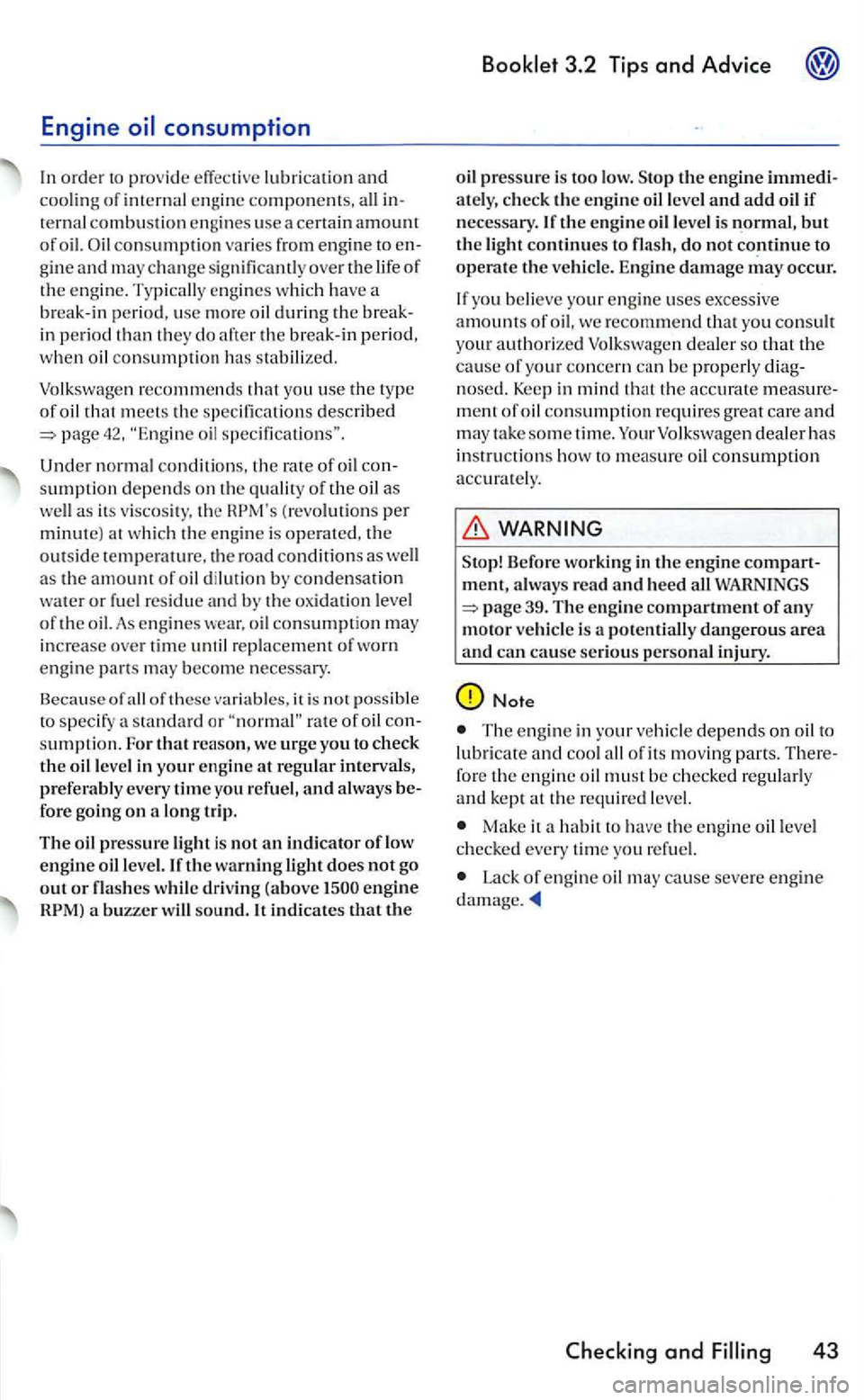
Engine
ternal combustion engines use a certain amount of oil.
th e break-in period,
when consumption has sta bili zed.
conditions, t he rate of
as its viscosity, th e
residue and by the oxidation level of the oil. As engines consumption may
increase over time
of thes e it is not rate of sumption. For reaso n, w e urge you to check the oil le vel in your engin e at regular interval s, prefe ra bl y every time yo u and always
fore go ing o n a trip.
The
en gine
pressure is too low. S to p the en gine ately, check th e en g in e o il leve l and add if
n ecessary . If th e e ng ine oil level is no rmal, but
th e light con tinues to flash, do not continue to
o pera te t he ve hicl e. Engine damage
so that th e cause of your concern can be pro perly
ment of consumpt ion requires great care and may take sometime. consumption
Sto p! Be fore workin g in the e ngine ment, always read an d heed all WARN INGS 39. The e ng in e compart m en t of any moto r ve hic le is a potentially dangero us a rea and can cause serious pe rsonal inju ry.
0Note
The eng ine in you r to all of it s movin g pa rts. fore th e en g in e must be ch ecked and kept at th e required
Make it a habit to have the engine
Lack of engine
and
Page 320 of 444
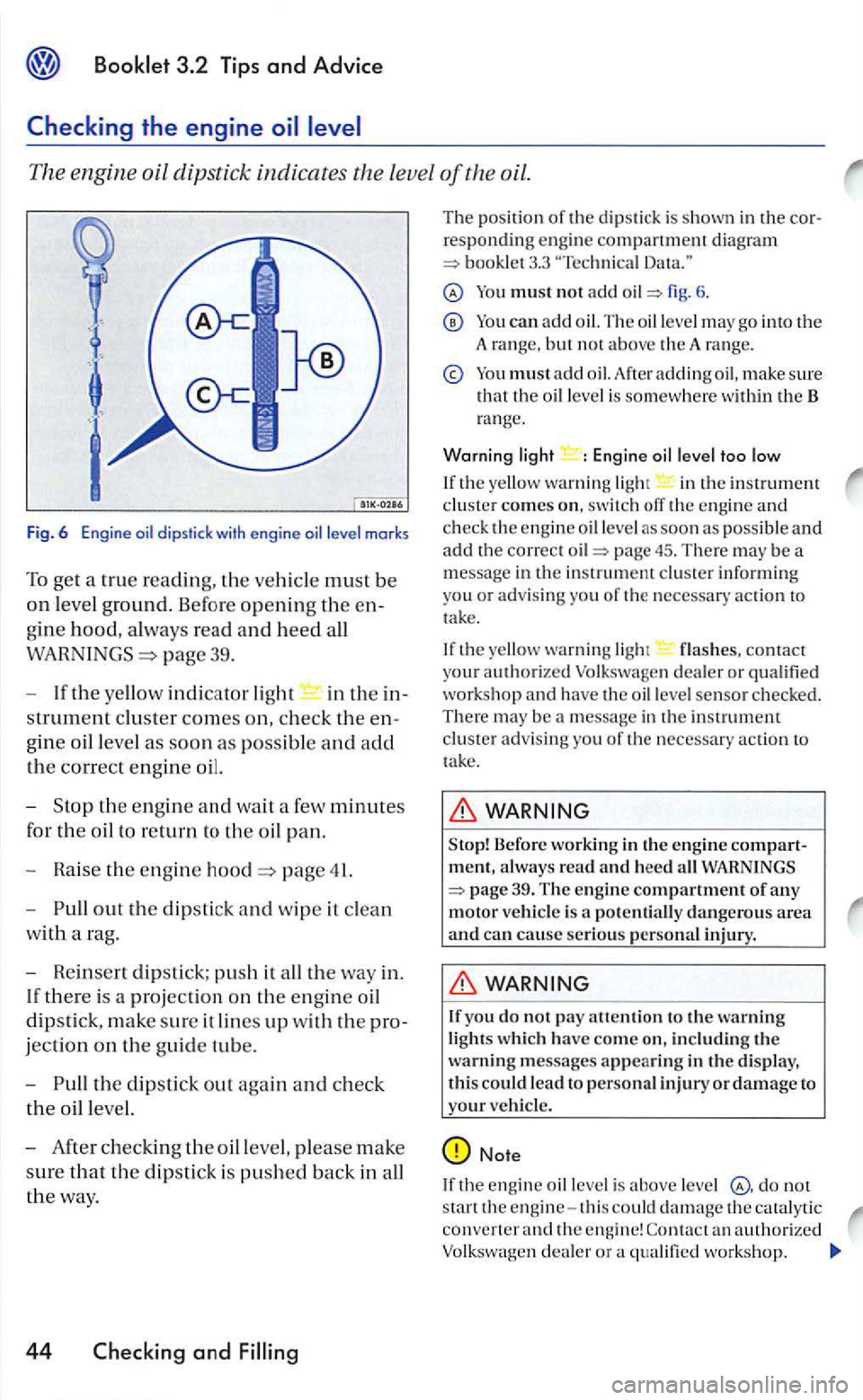
The engine oil dipstick indicates the leve l of the oil.
Fig. 6 E ngine level marks
To get a true reading, the ve hicl e must be
on leve l ground. Before opening the en
gine hood, always read and heed all
page 39.
If the yellow indicator light in th e in-
s
trument cluster comes on, check the e n
gine o
il leve l as soon as possible and add
the correct engin e oil.
the eng in e and wait a few minutes
for
the oil to return to the o il pan.
p a ge 41.
out the dipstic k and w ip e it clean
w ith a rag.
Rein se rt dips tick; push it all the way in.
If
ther e is a projection on the en gin e oi l
dipstick, make sure it lines up with the pro
jection on the guide tube.
the dipsti ck out aga in and ch eck
the o il l evel.
You must not add fig. 6 .
You can add
You m ust add oil. adding oil, make sure the level is somewhere within t h e B range.
Warning light : Engin e oi l level too low
If the yellow warn in g ligh t in the instrument cluster comes on, switc h ofT the engine and check the engine level as soon as possible and add the correct page 45. There may be a message in the instrumem cluste r informing you or advis ing you of the necessary action to
take.
If the yello w
warning ligh t flashes, contact your authorized Volkswa gen dealer or qualified workshop and have the oil leve l sensor checked. There be
WARN IN G
Before workin g in th e e ng in e compartm ent, always read and heed 39. T he engin e compartment of any motor vehicl e is potentiall y dangerous are a and can cause serio us personal injury.
WARN ING
If you do not pay attentio n to the warning light s which ha ve com e o n, incl ud in g the warning messages appearing in the d isplay, this could lead t o personal in juryordamage to
your ve hicle.
Note
If the engine oil is above level not
start the engine-this could damage the catal ytic converter and the engi ne!
Page 321 of 444
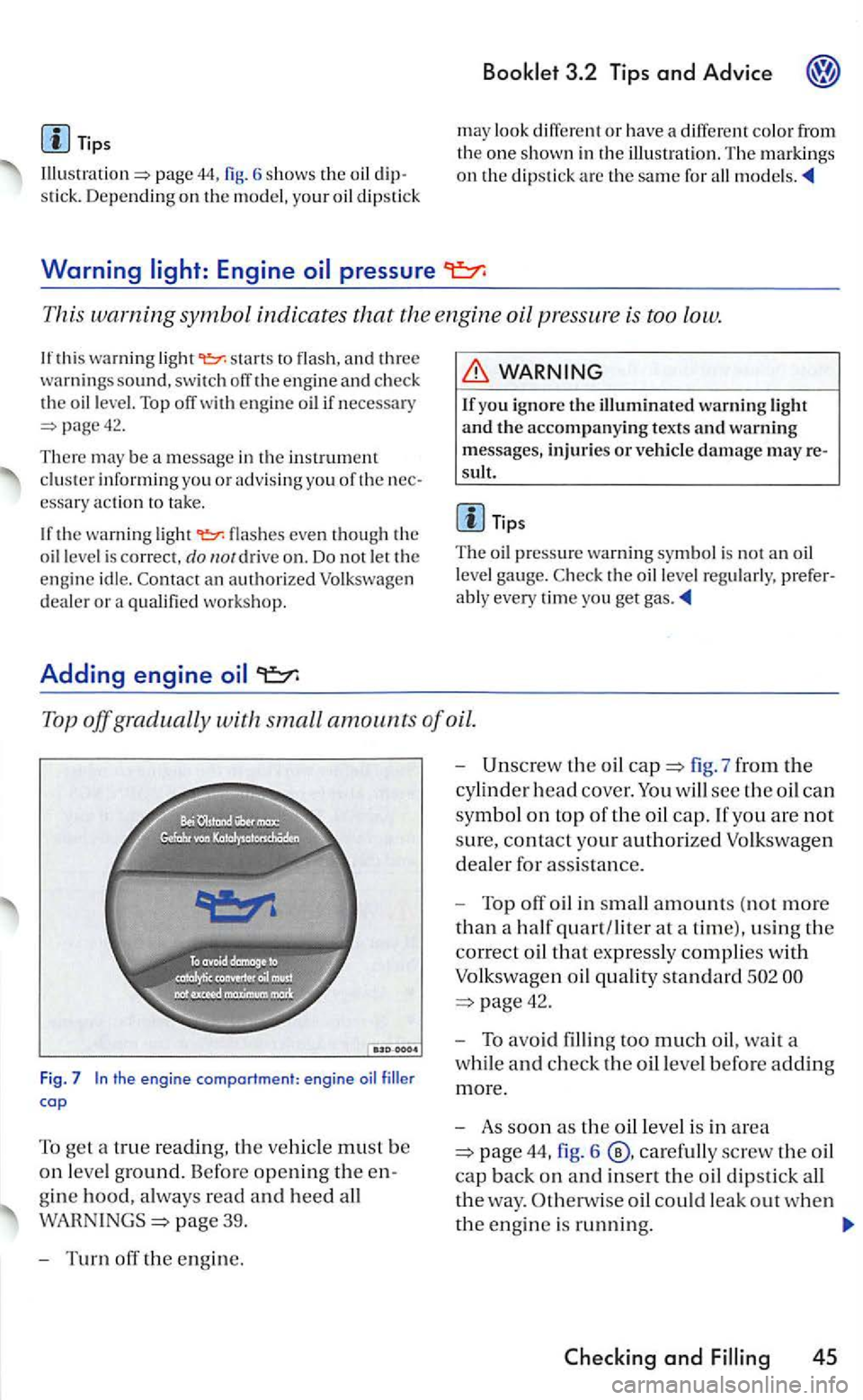
Tips
6 shows the oi l stick. Depending on the model, your dipstick
Booklet 3.2 Tips and Advice
may look different or have a different colo r from
t h e one shown in th e illustration. The markin gs on the dipstick are th e same for
Warning
This warning symbol indicates that the engine oil pressure is too low.
th is warning light start s to nash, and three warnings sound. switch off the engine and check the oil level. Top off with engine oil if necess ary
essary action to tak e.
If
the warning flas hes even the
oil le ve l is correct, do no/drive on. Do not ler the engine idle. Contact an authorized Volkswagen dealer or a qualified works hop.
Adding engine
WARNING
If yo u ignore the illum inated warning light and the accompanying texts and warning messages, injuries or vehicle damage may s ult.
Tips
The oil pressure warning symbol i s not an oil
level gauge. Check the oil leve l regu larly,
Top off gradually with small amounts of
Fig. 7
must b e
on leve l ground. Before opening the
WAHNINGS 39.
Turn off the e ngin e.
Un screw the oil fig. 7 from the
cy lind er head cover. see the can
symbol on to p of the oil cap. If you a re not
sure, con tact your authorized
off oil in amounts (not more
than a hal f quart/liter at a time). using the
correct oil that expressly complies with
quality standard
page42.
too much
As soon as the oil l evel is in area
d ipstick all
the way. Othetw ise oil could
and Filling 45
Page 322 of 444
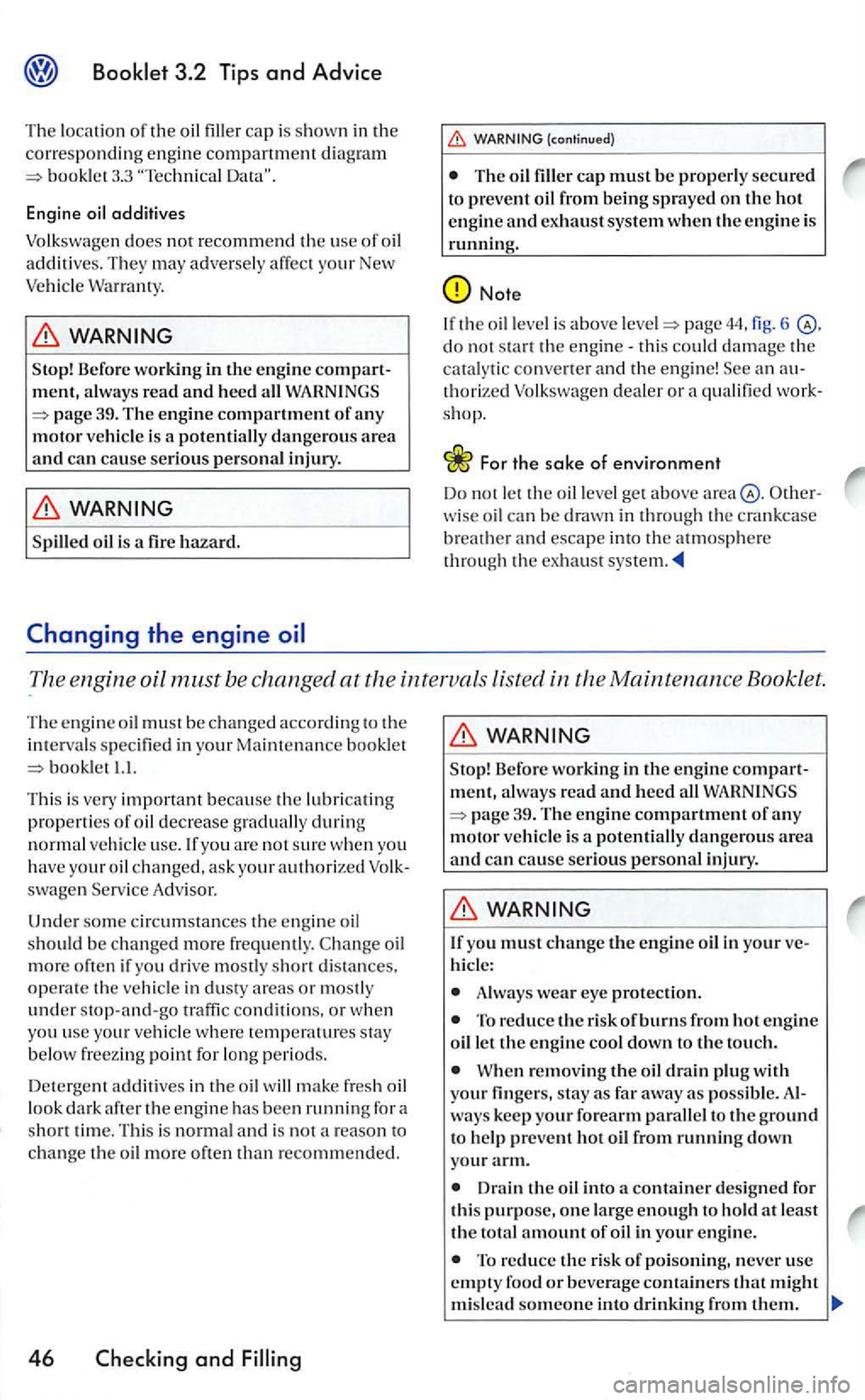
3.3
additives
Volkswagen
does not recommend the use of oil additives. They may adversel y affec t your New Vehicl e
Befor e worki ng in the engine compart
m ent, a lw ays read and heed all
Spilled oil is a fire hazard.
Changing the engine oil
(continued)
The oil filler cap must b e properly secured
to prevent oil from being sprayed o n the hot e ngine and exhaust system w hen the engin e is running.
th e oil is above pag e 44, fig. 6 do not start t he engine-thi s c ould damage the cata lytic convert er a nd the en g ine! a n au
t h orized Volkswage n dealer or a qualified work
s hop.
Fo r the sake of environment
Do not the oil leve l ge t above Other
wise oil can be drawn in throu gh the cra nkcase breather and escape in to the atmosp he re
throug h the exhaust system.
Th e engine oil must be changed at the interuals listed in the Maintenanc e Booklet .
The engine oil must b e changed according to the int erv a ls s pecified in your Maintenance booklet book le t 1.1.
Thi s is ve ry important beca use th e lubricatin g
prop ertie s of oil decreas e gra dually during
n ormal ve hicl e use . yo u arc not sure w hen you
hav e yo ur oil changed , ask your authorized Volkswagen Service A dvisor.
Und er
som e c irc um sta nc es the engin e oil
shoul d b e changed more frequently. more often if yo u drive mostly short distances. ope ra te the ve hicle in dusty area s or mostly under s top -and-go traffic conditi ons, or w hen
yo u use vehicle where stay
below fre e zin g point for long period s.
D eterg e
nt addit ive s in the oil will make fr es h oil
look dar k after the engine has been running for a short tim e. This is norm al and is not a reaso n to
c h a nge the oil more often than recommend ed .
46 Checking and
Before working in the engine compart
m ent, alway s read and heed a ll
yo u must chan ge the en gin e oil in your ve
hicl e:
Alwa ys wear eye protectio n.
To reduce the riskofburns from ho t engine
oil l e t the e ngine cool down to the to u ch.
W hen r emoving the oil dra in plu g with your fin gers, stay as far away as possibl e. Al
ways keep your forearm paralle l to the ground to help prevent hot oil from running down your arm.
Dra in the oil into a containe r designed for this purpose, one large enough to ho ld at least the tota l amount of oil in your engine.
To reduce the risk of poisoning, n e ver u se
empty food or beverage containe rs that might mis lead someon e into drinking from th em .
Page 330 of 444
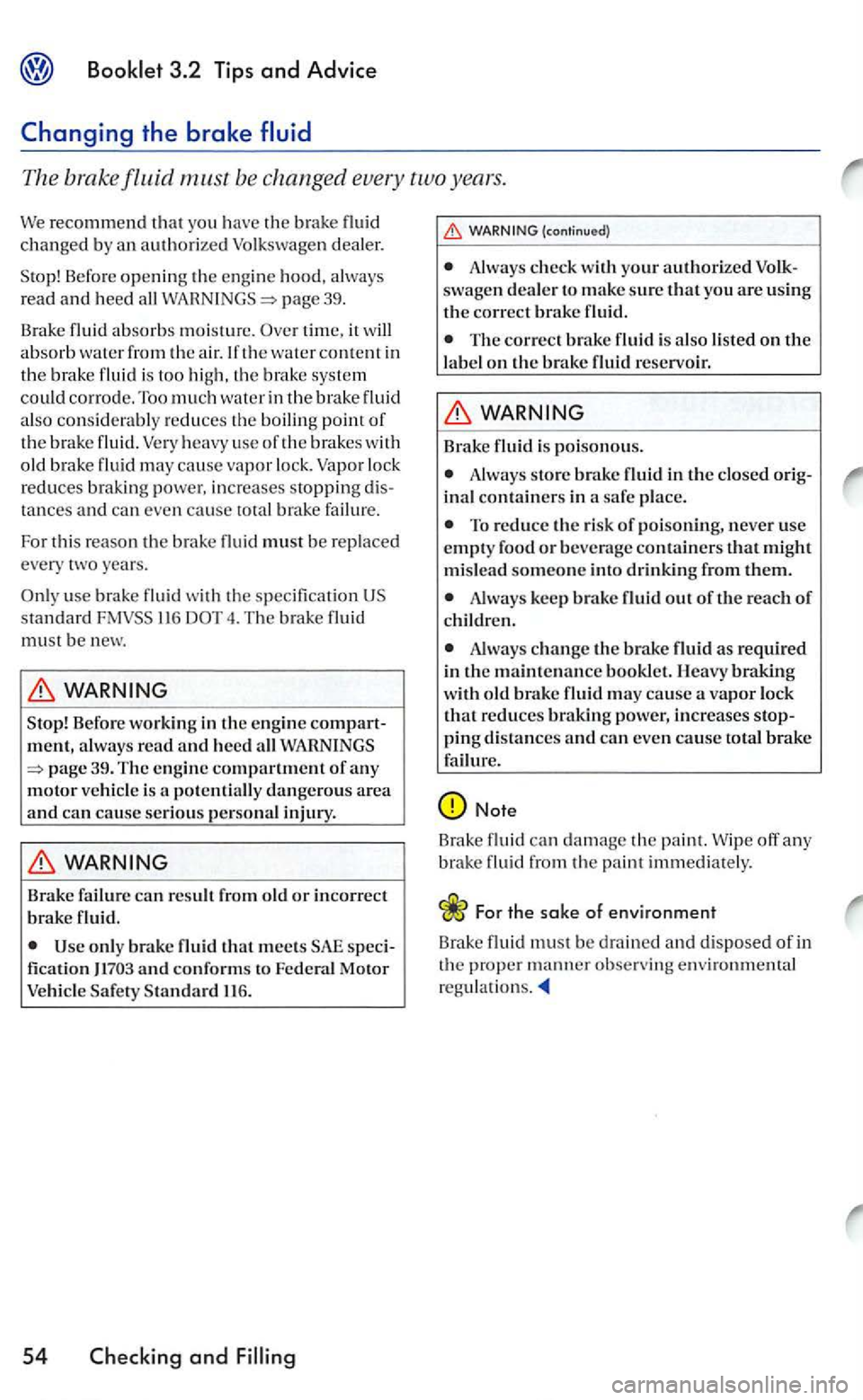
3.2 Tips and Advice
The brake fluid be changed every two years.
We recommend that you have the brak e changed b y an authorize d Volkswagen dealer.
S top! Be
fore openin g th e e ngin e hood, always
read and heed all page 39.
Brake fluid
absorbs m oisture. time, it will absorb wate r from the air. the wa ter content in the brak e fluid is too high, the brake sys te m
c
ould corrode. Too much wa te r in the brak e fluid
a lso consid erably reduces the boilin g point of the brake fluid. Very heavy use of th e brak es with
old brake fluid may cause vapor lock . Vapo r lock
reduces braking power, in cre ases stopping tances and can eve n cause total brake failu re.
For this r
eason the brake fluid must be repla ced
every two years.
use brak e fluid the s pecification U S standard 116 4. The brake fluid must be new.
Stop ! Befor e working in the engine compartment, always read and h eed all WARNINGS 39. The engine compartment of any motor vehicl e is a potentiall y dangerous area and can cause seriou s persona l injury .
Brake failure can result from old or incorrect brake fluid.
fica tio n
(continued)
A lwa ys check with your authorized swage n deale r to make sure that you arc u sing the correct brake fluid.
The correct brake fluid is also listed on the
labe l on the brak e fluid reservoir.
Always store brake fluid in the closed
To reduce th e risk of poisoning, neve r us e empty food or beverage containers that mi ght mislead someone into drinking from them.
A lwa ys keep bra ke flu id out of the reach of childr en.
Alway s change th e b rake fluid as required in the maintenance bookl et. Heavy braking w ith old brake fluid may cause a vapor lock that reduces braking power, increases ping distances and can even cause tota l brake failure.
Note
Brake fluid can damage the pai nt. Wip e off any
brake fluid from rh c paint immedia tely.
For the sake of environment
B rake fluid
must be drained and disposed of in
th e proper manner obse rv ing env ironmental
Page 386 of 444
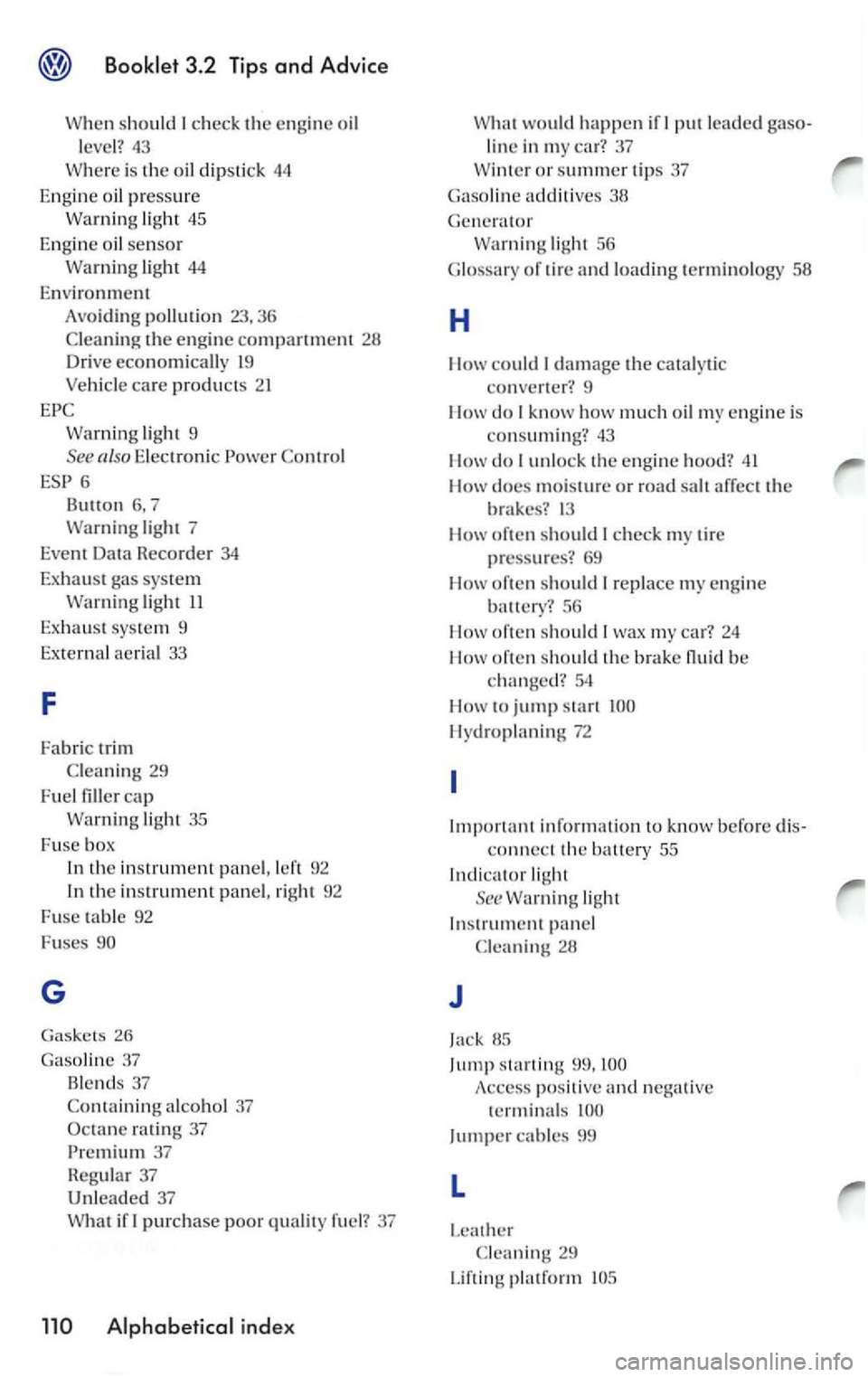
sh o uld I check the engine oil
level? 43
ligh t 45
Engine oil sensor li g h t 44
Environment Avoiding pollution 23, 36
the eng in e compartment 28 Drive economically 19
light 9
also E lectron ic
light 7
Even t Data Hecorder
34
Exhaus t system
light II
Exhau st system 9
Externa l
aeria l 33
F
Fabric trim
light 35
Fuse b ox
I n the in strument p anel , left 92
In the in strum ent pan el, rig h t 92
table 92
Fuses
G
Gaskets
Gasoline 37
Blends 37 alcohol 37
rating 37
37
Hegular 37 Unleaded 37 ifl purchase poor qua lity fu el? 37
woul d happen if I put leaded gaso
l
ine in my ca r? 37
or summer tips 37
Gasoline addi tives
Generator light 56
G lossary oft ire and loading terminology 58
H
I low co uld I damage the cata lytic
conve rter? 9
I low do I know how much oil en gi ne is
consuming'? 43
How do I unlock the en gine hood? 41
How doe s moisture or road salt affec t the brakes? 13
How ofte n should I check my tire
pressures? 69
How often should I replace my engine
battery?
56
How oft e n should I wax my 24
I low ofte n should th e brak e nuid be
c h anged?
54
I low to jump start
light
I n st
rument pane l 28
J
Jack
Jump starti n g
Access positive and negative
terminals
Jumper cables
L
Leather
Page 398 of 444
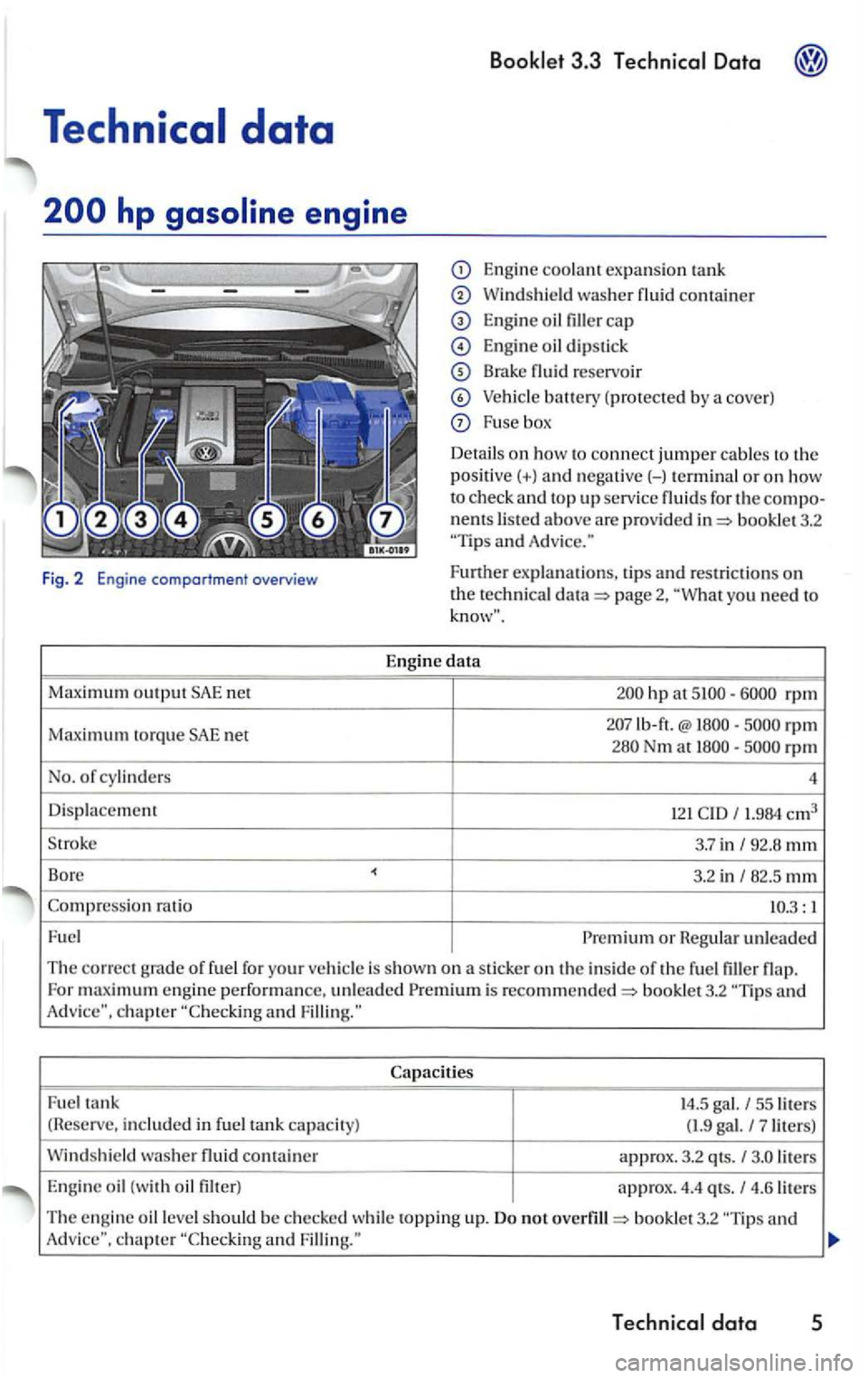
3.3
Compression ratio
Fu el
Engine coolant ex pansio n t ank
W indshield washer
Engine oil cap
Engine oil dipstick
Brake reservoir
(protected by a cove r)
Fus e box
Details on
how to connect jumpe r cab le s to the positive(+) and negative(-) te rminal or on how
t o check and top up service for the nents lis ted above are provid ed book le t 3.2 'Tip s and
Further explanations. tips an d res trict ions on the technical page 2, yo u need to
hp at rpm
rpm rpm
4
92.8
3.2 in 82.5 mm
or Hegul ar unleaded
The correct grade of fue l for your is shown on a sticke r o n th e in side of the f ue l For maximum e ng in e performance. unlead ed is bookl et 3.2 and c hapter
Capacities
Fuel tank 55 liters
( H eserve. ?liters)
W ind shield was h e r
container approx. 3.2 qts. liters
E ngi ne oi l (w ith oil filter )
a
pprox. 4.4 qts. 4.6 liter s
The engine oil leve l should be checke d whi le topping up. Do not boo klet 3.2 and chapter and Fillin g."